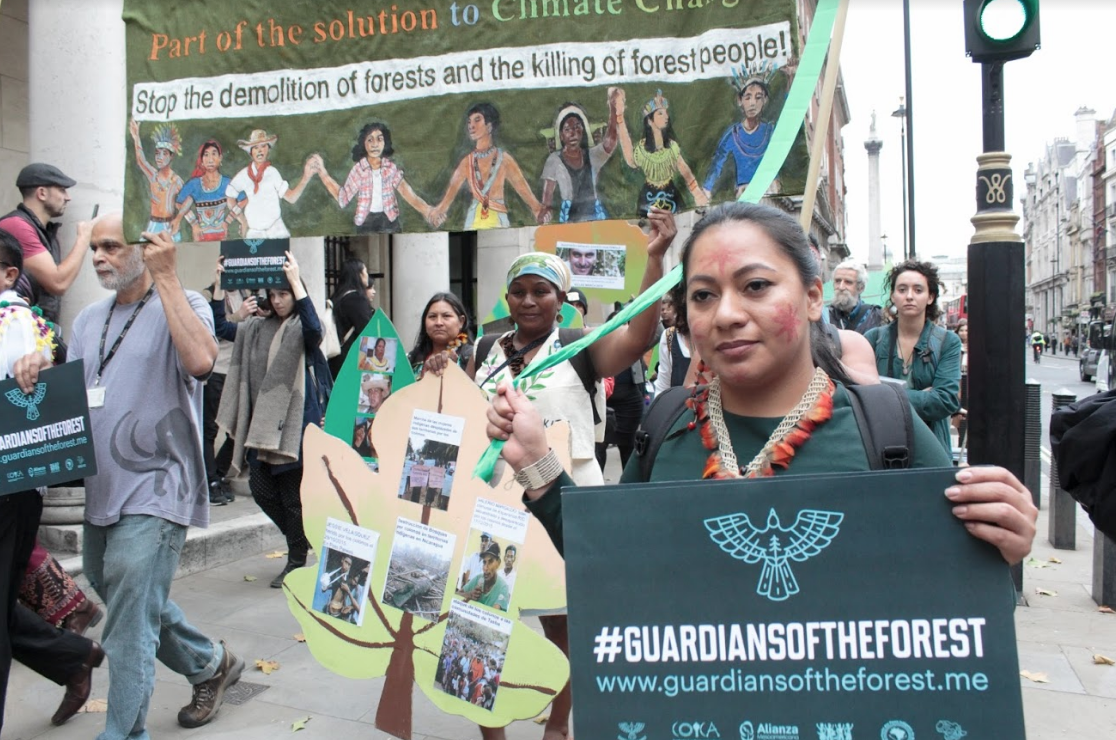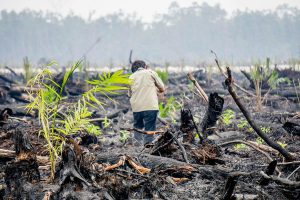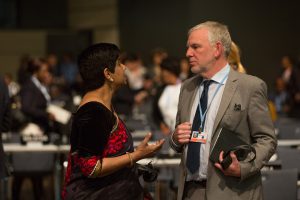A silent procession of indigenous leaders moved solemnly down London’s Whitehall on Wednesday to protest the violent destruction of their land and the persecution of their people.
Many carried placards bearing photos of murdered family members and compatriots, including Bertha Cáceres; other held posters of animal and bird species now lost from their forests; some burned sage, an act of purification.
The march was led by leaders from Brazil, French Guyana, Panama and Indonesia, who are touring Europe by bus communicating their message in the lead up to the United Nations climate summit in Bonn that starts on November 6.
At a press conference at the Royal Society, the leaders called on governments and their citizens to support an end to the murder and criminalisation of indigenous peoples around the world, the seizure of land rights and the destruction of native territory, and for a greater share of climate finance to be directed towards protecting forests, one of the planet’s most effective stores of the carbon emissions that drive climate change.
“If there are still forests standing today it’s because we still exist,” said Sonia Guajajara, coordinator general of COICA, the coordinating body of indigenous bodies in the Amazon basin, adding: “We are being brutally attacked by the forces that profit from agri-business and a model of development that was invented in the UK.”
“If there is no forest, no economy will survive,” she said.
Last year, 200 environmental protectors were murdered with 50 coming from Brazil, according a Global Witness report On Dangerous Ground.
“We avoid the bullets of hitmen and maintain our culture through the force of our spirit but they want to destroy all life that surrounds us,” said Guajajara, from the Guajajara tribe in the northeast state of Maranhão, the country’s most numerous indigenous group.
In August, Brazilian president Michel Temer abolished the Amazon’s vast RENCA reserve – 47,000 hectares of protected rainforest – to mining interests, provoking outcry from environmentalists who accuse the government of selling energy and mining contracts to secure financial investments at the cost of Brazil’s environment.
Some projects involve Chinese companies, such as the Belo Monte hydropower dam on one of the Amazon River’s main tributaries, which displaced 20,000 people when its reservoir overflowed in 2015. And the trans-continental railway, which threatens to displace uncontacted tribes.
Guajajara called the Samarco dam collapse in the state of Mines Gerais, which caused the deaths of 19 people and devastated livelihoods along the river, a “crime of ecocide”; and cited ongoing violent police attacks in Pernambuco state over land disputes and the revocation of indigenous rights.
She called for the European Union and international governments to support embargoes against companies that destroy forests and pollute rivers, seas and oceans.
“Construction plans [go ahead] without the consent of the people and then sold as clean energy. Those who practice forest fires must be punished for crimes against humanity,” she said.
Finance gap
The event coincided with the launch of a new report on forest financing from environmental group Climate Focus in partnership with the Progress on the New York Declaration on Forests, a coalition of 15 non-profits calling to end natural forest loss by 2030.
Only 2% of climate funding from governments and multilateral lending institutions since 2010 has gone to protecting forests. Yet forests can contribute as much as 30% of the climate change mitigation needed to reach the Paris climate goal of limiting global warming to 2C, found the report.
Global deforestation spiked in 2015 and 2016 driven by the production of hard woods, soy, palm oil, gold, petroleum, hydropower and industrial agriculture, leading to “a drastic rise in forest loss”, according to Franziska Haupt, senior land use consultant at Climate Focus.
The report found that US$777 billion was invested in agriculture and land development compared to a paltry US$20 billion channelled toward fighting deforestation, since 2010.
Clare Shakya, director of climate change at the International Institute for Environment and Development said that less than 10% of climate finance reached the front line of these communities.
Alain Frechette, director of strategic analysis and global engagement at non-governmental organisation Rights and Resources, said that forests protected by communities are proven to have lower rates of deforestation and higher rates of carbon storage.
Community forests sequester 36% more carbon on average than those that are not and suffer 11 times less deforestation.







![A view of receding flood waters in Srinagar city during the September 2014 flooding. [image: Athar Parvaiz]](https://dialogue.earth/content/uploads/2017/11/A-view-of-receding-flood-waters-in-Srinagar-city-during-the-September-2014-flooding-Credit-Athar-Parvaiz-e1509633052651-300x225.jpg)
